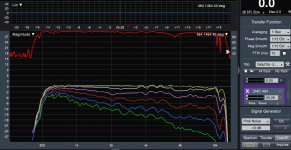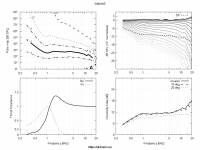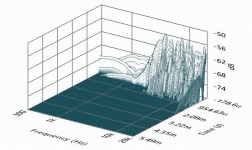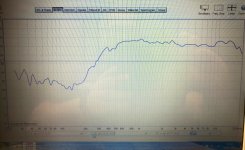From what I can see, the old config files no longer work in ATH 4.7.1?
The new config files features this format:
ABEC.Polars:SPL = {
MapAngleRange = 0,90,19
NormAngle = 10 ; [deg]
Distance = 3 ; [m]
Offset = 95 ; [mm]
}
But there's no apparrent way to generate polars on the X and the Y axis?
When I include a stanza like this, it doesn't work. (It used to.)
ABEC.Polars.Dist = 2 ; [m]
ABEC.Polars.Step = 7.5 ; [deg]
ABEC.Polars.Points = 8
ABEC.Polars.Horizontal = 1
ABEC.Polars.Vertical = 1
ABEC.Polars.Diagonal = 0
ABEC.Polars.DiagonalInclination = 0.0
The new config files features this format:
ABEC.Polars:SPL = {
MapAngleRange = 0,90,19
NormAngle = 10 ; [deg]
Distance = 3 ; [m]
Offset = 95 ; [mm]
}
But there's no apparrent way to generate polars on the X and the Y axis?
When I include a stanza like this, it doesn't work. (It used to.)
ABEC.Polars.Dist = 2 ; [m]
ABEC.Polars.Step = 7.5 ; [deg]
ABEC.Polars.Points = 8
ABEC.Polars.Horizontal = 1
ABEC.Polars.Vertical = 1
ABEC.Polars.Diagonal = 0
ABEC.Polars.DiagonalInclination = 0.0
I think this was how the simulation worked out -Remember this was a coaxial compression driver. This is about as good as it gets for that kind of device. ...
Attachments
Yes, sorry about that. You have to set an inclination angle for anything else than the horizontal. It's missing in the manual:...
But there's no apparrent way to generate polars on the X and the Y axis?
ABEC.Polars:SPL_V = {
MapAngleRange = 0,90,19
NormAngle = 10 ; [deg]
Distance = 3 ; [m]
Offset = 95 ; [mm]
Inclination = 90 ; [deg]
}
Last edited:
Remember this was a coaxial compression driver. This is about as good as it gets for that kind of device. The good thing is that there are no vertical lobes above the lower xover point - what you see is basically the complete behaviour of the loudspeaker in that band.
Would you consider a coaxial CD yourself?
//
I don't believe that this is correct.
If there is a reflection at the mouth that causes a standing wave inside of the device, then these resonances will be as constant throughout the sound field as a resonance in the driver itself.
Dear Mr. Geddes, the horn previously didn't had the rollback on the mouth. With this version I had the problem with a reflection (i guess it was a reflection) on the axis up to about 20 degrees. From 20 degrees and more it comes to a peak. So the gain on axis and 30 degrees out of axis were nearly the same. And I also had the problem with the box behind the horn. The rollback version is much more tolerant of what is behind the horn. I have to say, that the horn without the rollback was a 90 degrees design. First i tried to eliminate the reflexion with different damping materials on the mouth and also on the cab behind. The result was clearly bether but not to handle for professional use.
isitone, Very nice! did you turn it manually with some jig/template? I mean it is pretty accurate work, the measurements are really good.
May I ask how many hours of work went into it and how much experience is needed to achieve such piece? One of my relatives has suitable lathe but I don't have very high hopes turning one yet since I don't have experience and the owner is not into audio nor precision 😀 It could be nice if you gave a quick summary what it takes to turn such horn at home? Thanks!
Dear Mr. tmuikku, yes, I have a template for the profile. In my first profession i was carpenter and i have e little bit the feeling for woodworking. But if you watch some videos how to work it with a lathe you will find the way fast and easy. I will you give the courage to try it.
The ripples / resonances are likely - at least to some extent, inherent to the DCX464's design, probably due to interference from the HF diaphragm and the exit channel.
The ripples (> 8k) are at least present in the plots I've seen from the DCX464.
Perhaps Mark(100) has some measurement data for comparison.
The ripples (> 8k) are at least present in the plots I've seen from the DCX464.
Perhaps Mark(100) has some measurement data for comparison.
The ripples / resonances are likely - at least to some extent, inherent to the DCX464's design, probably due to interference from the HF diaphragm and the exit channel.
The ripples (> 8k) are at least present in the plots I've seen from the DCX464.
Perhaps Mark(100) has some measurement data for comparison.
Hi Ro,
I posted this some time ago in the dcx464 thread...so nothing new.
When i saw the lack of coherence in it at above 16kHz, I thought i'd grab some new outdoor measurements this morning as there is no wind today...but not to be...boats, waves on shore etc....coherence fell everywhere.
Anyway, it's the dcx464 on xt1464 which is the best behaved horn i have.
Hey, a question for all:
How do you like to see polars in these type mag vs freg graphs?
Do you EQ on-axis (or whatever near to on-axis angle is chosen to tune to), and then measure polars?
This is what I like and is in graph below.
Or do you measure raw and show raw?
I use this for choosing xover points, but find it too difficult to judge horn performance, trying to see if ripples are uniform across angles.
Or do you prefer to measure raw, then show normalized to on-axis?
(Have to admit, this is my least favorite to see)
Thanks ! mark

.
Sure, why not.
My experience with these has not been good. There is always a problem at the crossover point between the two diaphragms.
My experience with these has not been good. There is always a problem at the crossover point between the two diaphragms.
May i ask which particular coax CD's you have had trouble with?
Anyway, it's the dcx464 on xt1464 which is the best behaved horn i have.
That's as good as it gets.
Vance Dickason's HF waterfall with the prototype La Tromba horn and the DCX with the ME464 for comparison (mind the 10 dB increments):
Attachments
Last edited:
Obviously it's not "always". Or do you see any problem in what isitone showed?My experience with these has not been good. There is always a problem at the crossover point between the two diaphragms.
Well, the resonance in the HF unit at 5,5k seem to be coming back as the first bigger wiggle (dip!) in the combined FR at just 5,5k. Buts thats really not at the XO point (?). I'm sure the XO have the same problems as any xovered system - and then maybe some as it seem that the mid and hf membranes are physically connected somehow?
My question was around the penalty of a xo vs. more EQ to the top? Given one wanted to get the same BW from a single and a 2 way CD?
//
My question was around the penalty of a xo vs. more EQ to the top? Given one wanted to get the same BW from a single and a 2 way CD?
//
At least the lobing is gone, so that's definitely one problem less.I'm sure the XO have the same problems as any xovered system
That's too general question. Personally, I chose HF1440 over DCX464 for the money but that doesn't mean anything. The coaxials seem to get better and better.My question was around the penalty of a xo vs. more EQ to the top? Given one wanted to get the same BW from a single and a 2 way CD?
Thanks!
Do you now play your HF1400 / big-sand in stereo?
If so, what do you think about them?
//
Do you now play your HF1400 / big-sand in stereo?
If so, what do you think about them?
//
No, I still build a CNC machine for making moulds for those. That's part of the fun for me. Have it almost ready to test the firmware (Ath will generate a "gcode")...
Last edited:
OK - I thought what is called "big sand horn" was the ones that came along with all the 260s you got made... I'm now confused of the models in the working... 🙂
//
//
- Home
- Loudspeakers
- Multi-Way
- Acoustic Horn Design – The Easy Way (Ath4)


